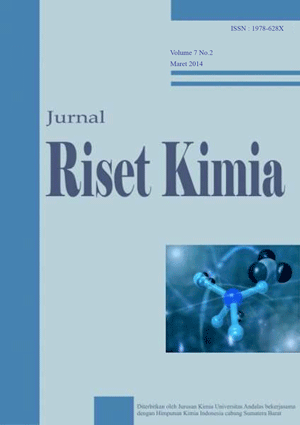PEMBUATAN PASTA DAN PEMBENTUKAN LAPISAN TIPIS HIDROKSI APATIT KARBONAT
DOI:
https://doi.org/10.25077/jrk.v7i2.180Abstract
Â
ABSTRACT
Paste of Carbonated Hydroxyapatite (CHA) as a biocompatible material that can be used in the
bone and teeth repair has been developed on preparation of thick film. CHA paste was prepared
by mixing precipitate of CHA with CaSO4 and polyethylene glycol (PEG) in 2-propanol as
solvent. Paste was deposited on substrate to get thick films by screen printing method. X ray
diffraction (XRD) analysis has shown hexagonal crystal structure and crystal size of CHA
acquired 7,2 nm by Scherrer’s method. Fourier Transform Infrared (FTIR) analysis has shown
absorption spectra which indicating phosphate, carbonate, and hydroxide group. Size of this
composite particles analyzed by PSA (particle size analyzer) about 3μm and pore size was 0.44-
0.49 nm obtained from BET analysis, increased with the addition of CaSO4 (0.44 to 0,49 nm).
Rephrase PEG was found as an adhesive and homogenize paste on substrat surface. In addition,
CHA paste also potentially can be used as bone cement.
Keywords : Paste, thick film, carbonated hydroxyapatite
Downloads
Published
How to Cite
Issue
Section
Citation Check
License
Please find the rights and licenses in Jurnal Riset Kimia (J. Ris. Kim). By submitting the article/manuscript of the article, the author(s) agree with this policy. No specific document sign-off is required.
1. License
The use the article will be governed by the Creative Commons Attribution license as currently displayed on Creative Commons Attribution 4.0 International License.Â
2. Author(s)' Warranties
The author warrants that the article is original, written by stated author(s), has not been published before, contains no unlawful statements, does not infringe the rights of others, is subject to copyright that is vested exclusively in the author and free of any third party rights, and that any necessary written permissions to quote from other sources have been obtained by the author(s).
3. User Rights
Under the Creative Commons license, the journal permits users to copy, distribute, and display the material for any purpose. Users will also need to attribute authors and J. Ris. Kim on distributing works in the journal and other media of publications.
4. Rights of Authors
Authors retain all their rights to the published works, such as (but not limited to) the following rights;
- Copyright and other proprietary rights relating to the article, such as patent rights,
- The right to use the substance of the article in own future works, including lectures and books,
- The right to reproduce the article for own purposes,
- The right to self-archive the article,
- The right to enter into separate, additional contractual arrangements for the non-exclusive distribution of the article's published version (e.g., post it to an institutional repository or publish it in a book), with an acknowledgment of its initial publication in this journal.
5. Co-Authorship
If the article was jointly prepared by more than one author, any authors submitting the manuscript warrants that he/she has been authorized by all co-authors to be agreed on this copyright and license notice (agreement) on their behalf, and agrees to inform his/her co-authors of the terms of this policy. J. Ris. Kim will not be held liable for anything that may arise due to the author(s) internal dispute. J. Ris. Kim will only communicate with the corresponding author.












